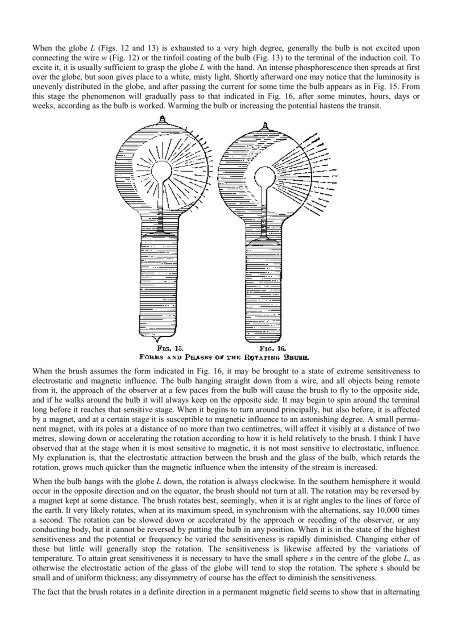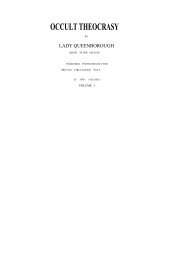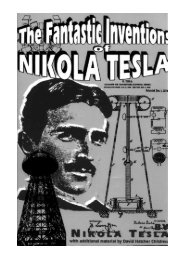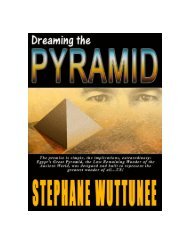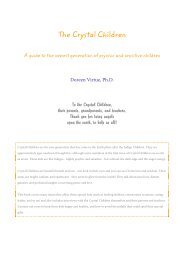the fantastic inventions of nikola tesla - Exopolitics Hong Kong
the fantastic inventions of nikola tesla - Exopolitics Hong Kong
the fantastic inventions of nikola tesla - Exopolitics Hong Kong
You also want an ePaper? Increase the reach of your titles
YUMPU automatically turns print PDFs into web optimized ePapers that Google loves.
When <strong>the</strong> globe L (Figs. 12 and 13) is exhausted to a very high degree, generally <strong>the</strong> bulb is not excited upon<br />
connecting <strong>the</strong> wire w (Fig. 12) or <strong>the</strong> tinfoil coating <strong>of</strong> <strong>the</strong> bulb (Fig. 13) to <strong>the</strong> terminal <strong>of</strong> <strong>the</strong> induction coil. To<br />
excite it, it is usually sufficient to grasp <strong>the</strong> globe L with <strong>the</strong> hand. An intense phosphorescence <strong>the</strong>n spreads at first<br />
over <strong>the</strong> globe, but soon gives place to a white, misty light. Shortly afterward one may notice that <strong>the</strong> luminosity is<br />
unevenly distributed in <strong>the</strong> globe, and after passing <strong>the</strong> current for some time <strong>the</strong> bulb appears as in Fig. 15. From<br />
this stage <strong>the</strong> phenomenon will gradually pass to that indicated in Fig. 16, after some minutes, hours, days or<br />
weeks, according as <strong>the</strong> bulb is worked. Warming <strong>the</strong> bulb or increasing <strong>the</strong> potential hastens <strong>the</strong> transit.<br />
When <strong>the</strong> brush assumes <strong>the</strong> form indicated in Fig. 16, it may be brought to a state <strong>of</strong> extreme sensitiveness to<br />
electrostatic and magnetic influence. The bulb hanging straight down from a wire, and all objects being remote<br />
from it, <strong>the</strong> approach <strong>of</strong> <strong>the</strong> observer at a few paces from <strong>the</strong> bulb will cause <strong>the</strong> brush to fly to <strong>the</strong> opposite side,<br />
and if he walks around <strong>the</strong> bulb it will always keep on <strong>the</strong> opposite side. It may begin to spin around <strong>the</strong> terminal<br />
long before it reaches that sensitive stage. When it begins to turn around principally, but also before, it is affected<br />
by a magnet, and at a certain stage it is susceptible to magnetic influence to an astonishing degree. A small permanent<br />
magnet, with its poles at a distance <strong>of</strong> no more than two centimetres, will affect it visibly at a distance <strong>of</strong> two<br />
metres, slowing down or accelerating <strong>the</strong> rotation according to how it is held relatively to <strong>the</strong> brush. I think I have<br />
observed that at <strong>the</strong> stage when it is most sensitive to magnetic, it is not most sensitive to electrostatic, influence.<br />
My explanation is, that <strong>the</strong> electrostatic attraction between <strong>the</strong> brush and <strong>the</strong> glass <strong>of</strong> <strong>the</strong> bulb, which retards <strong>the</strong><br />
rotation, grows much quicker than <strong>the</strong> magnetic influence when <strong>the</strong> intensity <strong>of</strong> <strong>the</strong> stream is increased.<br />
When <strong>the</strong> bulb hangs with <strong>the</strong> globe L down, <strong>the</strong> rotation is always clockwise. In <strong>the</strong> sou<strong>the</strong>rn hemisphere it would<br />
occur in <strong>the</strong> opposite direction and on <strong>the</strong> equator, <strong>the</strong> brush should not turn at all. The rotation may be reversed by<br />
a magnet kept at some distance. The brush rotates best, seemingly, when it is at right angles to <strong>the</strong> lines <strong>of</strong> force <strong>of</strong><br />
<strong>the</strong> earth. It very likely rotates, when at its maximum speed, in synchronism with <strong>the</strong> alternations, say 10,000 times<br />
a second. The rotation can be slowed down or accelerated by <strong>the</strong> approach or receding <strong>of</strong> <strong>the</strong> observer, or any<br />
conducting body, but it cannot be reversed by putting <strong>the</strong> bulb in any position. When it is in <strong>the</strong> state <strong>of</strong> <strong>the</strong> highest<br />
sensitiveness and <strong>the</strong> potential or frequency be varied <strong>the</strong> sensitiveness is rapidly diminished. Changing ei<strong>the</strong>r <strong>of</strong><br />
<strong>the</strong>se but little will generally stop <strong>the</strong> rotation. The sensitiveness is likewise affected by <strong>the</strong> variations <strong>of</strong><br />
temperature. To attain great sensitiveness it is necessary to have <strong>the</strong> small sphere s in <strong>the</strong> centre <strong>of</strong> <strong>the</strong> globe L, as<br />
o<strong>the</strong>rwise <strong>the</strong> electrostatic action <strong>of</strong> <strong>the</strong> glass <strong>of</strong> <strong>the</strong> globe will tend to stop <strong>the</strong> rotation. The sphere s should be<br />
small and <strong>of</strong> uniform thickness; any dissymmetry <strong>of</strong> course has <strong>the</strong> effect to diminish <strong>the</strong> sensitiveness.<br />
The fact that <strong>the</strong> brush rotates in a definite direction in a permanent magnetic field seems to show that in alternating


